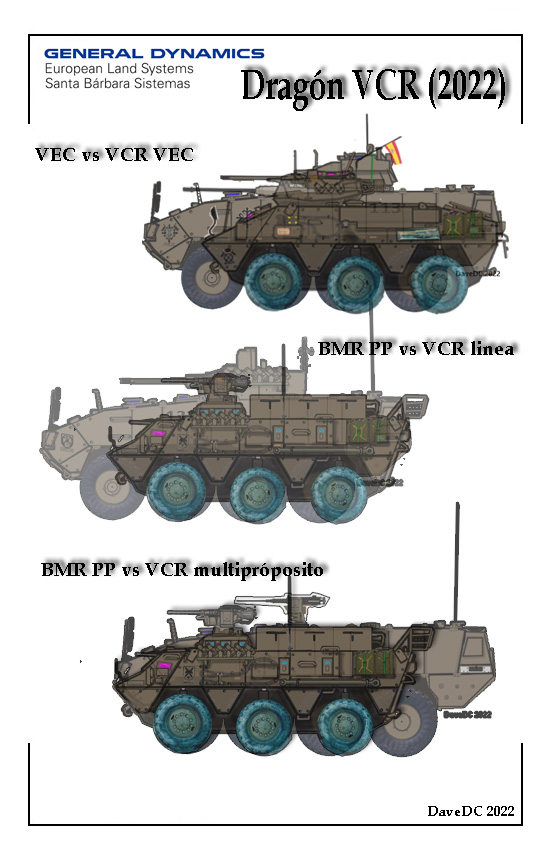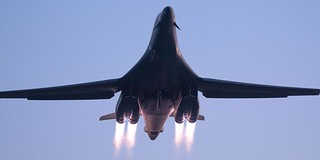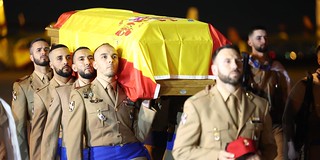The new VCR Dragón armored vehicle of the Spanish Army and the controversy over its size
Next Tuesday, December 20, the first seven Dragon Wheeled Combat Vehicles (VCR) will be delivered to the Spanish Army.
As we have already seen here, in 2020 the Spanish Ministry of Defense signed the purchase of 348 vehicles of this type for an amount of 1,740 million euros. It is expected that they will replace the BMR-600 armored vehicles and the VEC M-1 Cavalry Exploration Vehicles. Currently, the Army has 648 BMR-600 and 135 VEC M-1, so that 348 Dragon VCRs are not enough. Already in 2020 there was talk of a second phase in which another 348 vehicles would be contracted and a third with 287 more armored vehicles.

Already before its entry into service, a controversy has been generated about the size of the Dragon VCR. In January, Jesús M. Pérez Triana, a security and defense analyst, published an interesting article on his blog Guerras Posmodernas addressing the issue of the excessive size of this armored vehicle and the challenges that this can pose for its transportation aircraft, not only because of its size, but also because of its weight, which is estimated at 35 tons.

According to the Spanish Ministry of Defense, the Airbus A400M Atlas It has a maximum cargo capacity of 37 tons, and as the CISDE Observatory has pointed out the cargo hold of this plane measures 17.7 meters long, 4 meters wide and 3.85 meters high, which would allow it to be accommodated. The problem comes from the fact that the A400M's ramp only supports a weight of 32 tons, a limit that would exceed the Dragon VCR by 3 tons.
Germany already ran into this same problem two years ago with its 8x8 Rheinmetall Boxer armored vehicles, which also weigh 35 tons. However, the Luftwaffe has already carried out load tests on the Boxer successfully, due to the fact that it is a modular vehicle: a mission module is installed at the rear according to the needs of the operation, which can be disassemble for air transport. In the event of having to transport two Boxers, the Luftwaffe would need three A400Ms: two to transport the vehicles and one more to transport the two mission modules.
The problem with the VCR Dragon is that, unlike the Boxer, it is not a modular vehicle. It does not have a rear mission module that can be easily removed. In any case, its turret could be removed to reduce its weight, but it is not an easy process. The Spanish Army and the Spanish Air Force will have to see how to solve this problem.

Regarding the size of the Dragon VCR, this photo published yesterday by Roberto Gutiérrez has been highly commented showing a presentation of this vehicle by Tess Defense, the manufacturer consortium, at the Toledo Infantry Academy. This photo has reignited the controversy about the "giantism" of the Dragon VCR, even with comments from Italy. In case we want to get a better idea of the dimensions of the new vehicle, David Díaz, author of excellent pictures about Spanish Army vehicles that has published in various books (I recommend them), made this comparison between the Dragon VCR, the BMR-600 and the VEC M-1:

As can be seen, the Dragon VCR dwarfs its predecessors. The reasons for this increase in size, as Jesús M. Pérez Triana pointed out in the aforementioned article, are the reinforcement of the protection that these new vehicles bring against land mines and improvised explosive devices (IEDs). Not unique to the Dragon VCR. We have already seen that the same thing happens with the Boxer, and there are more cases. In this image published in 2018 by Warfare Blog we can see the tests that the Australian Army did in 2018 of the Boxer CRV (first from the left) and the Finnish Patria AMV (second from the left). Here we see them next to an M-1A1 Abrams main battle tank and an LAV-25 armored vehicle.

There are more examples of "gigantism" in other 8x8 armored vehicles, such as the Chinese Type 08, the Israeli Eitan AFV, the Turkish Otokar Arma, the Russian VPK-7829 Bumerang. the French VBCI and American Amphibious Combat Vehicle (ACV).

The problem does not affect only 8x8 armored vehicles, nor is it a recent problem. Remember that the small M151 MUTT SUV was replaced by the big Humvee, and this in turn has given way to the even bigger Oskosh JLTV. As in the case of the 8x8, the raison d'être of this "giganticism" is to offer more protection to the crews of the vehicles, even if that means reducing their deployment capacity. The paradox is that these large vehicles have left a gap that is being filled by smaller vehicles, capable of being transported in tactical transport aircraft or in C-47 Chinook helicopters, such as the M1161 Growler, the American Polaris MRZR and SRTV and the Spanish "mechanical mule" Falcata.

---
Photos: Ejército de Tierra / Tess Defense.
|
Don't miss the news and content that interest you. Receive the free daily newsletter in your email: |
- Most read
- The brutal 'touch and go' of a Lufthansa Boeing 747 at Los Angeles Airport
- A Spanish pilot shows one of the C-295M of the 353 Special Operations Squadron
- An American airman used a Flag of Spain to direct a B-1B Lancer bomber
- Eurofighter vs F-35: the opinions of professional pilots on these advanced fighters
- The massive takeoff of more than half of the United States B-2 Spirit stealth bombers
- The firearms used by the Pontifical Swiss Guard, the smallest army in the world
- E-4B Nightwatch: this is the inside of the 'Doomsday Plane' of the US Air Force

 ES
ES







Opina sobre esta entrada: